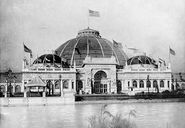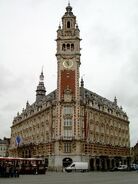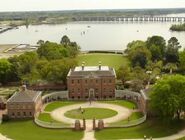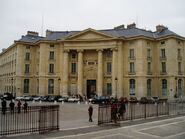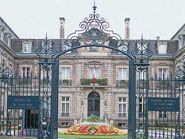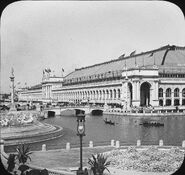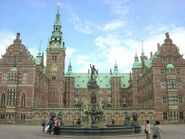|
| |||
| The Duchy of Thornbury | |||
| |||
| Motto Memores Acti Prudentes Futuri Latin: "Mindful of What Has Been Done, Aware of What Will Be" | |||
| National Anthem God Save the Duke | |||
| Capital City | Blickling | ||
|---|---|---|---|
| Official Language(s) | English, French, Italian | ||
| Established | 05/07/2009 (5,461 days old) | ||
| Government Type | |||
| Ruler |  His Grace, Lord Lee Allen, 1st Grand Duke of Thornbury | ||
| Alliance | The Democratic Order | ||
| Nation Team | |||
| Statistics as of 04/15/10 | |||
| Total population | 31,627 | ||
| 24,927 civilians | |||
| 6,700 soldiers | |||
| Literacy Rate | 93.88% | ||
| Religion | |||
| Currency | |||
| Infrastructure | 3,243.80 | ||
| Technology | 217.50 | ||
| Nation Strength | 12,065.151 | ||
| Nation Rank | 9,146 of 5,242 (174.48%) | ||
| Total Area | 1,136.592 mile diameter | ||
| Native Resources | Rubber & Silver | ||
| Connected Resources | Aluminum, Coal, Gems, Gold, Iron, Lead, Lumber, Marble, Oil, Spices | ||
| Bonus Resources | Steel, Automobiles, Fine Jewelry, Construction, Microchips, Radiation Cleanup, Asphalt, Scholars | ||
The Grand Duchy of Thornbury is a medium sized, mostly developed, and old nation at 343 days old with citizens primarily of British ethnicity whose religion is Judaism. Its technology is first rate and its citizens marvel at the astonishing advancements within their nation. Its citizens pay extremely high taxes and many despise their government as a result. The citizens of the Grand Duchy of Thornbury work diligently to produce Silver and Rubber as tradable resources for their nation. It is a very passive country when it comes to foreign affairs and has no interests in war. The Grand Duchy of Thornbury is currently researching nuclear technology for the use of nuclear power plants but believes nuclear weapons should be banned. Plans are on the way within the Grand Duchy of Thornbury to open new rehabilitation centers across the nation and educate its citizens of the dangers of drug use. The Grand Duchy of Thornbury allows its citizens to protest their government but uses a strong police force to monitor things and arrest lawbreakers. It welcomes all new immigrants with open borders. The Grand Duchy of Thornbury believes in the freedom of speech and feels that it is every citizen's right to speak freely about their government. The government gives foreign aid when it can, but looks to take care of its own people first. The Grand Duchy of Thornbury will not make deals with another country that has a history of inhuman treatment of its citizens.
The Former County of Norfolk[]
- From Wikipedia, the free encyclopedia
Norfolk is a low-lying county in the East of England. It has borders with Lincolnshire to the west, Cambridgeshire to the west and southwest and Suffolk to the south. Its northern and eastern boundaries are the North Sea coast, including the Wash. The county town is Norwich. Norfolk is the fifth largest ceremonial county in England, with an area of 5,371 km² (2,074 sq. mi.).
Norfolk was settled in pre-Roman times, with neolithic camps along the higher land in the west where flints could be quarried.[1] A Brythonic tribe, the Iceni, inhabited the county from the first century BCE, to the end of the first century (CE). The Iceni revolted against the Roman Invasion in 47 CE, and again in 60 CE led by Boudica. The crushing of the second rebellion opened the county to the Romans. During the Roman era roads and ports were constructed throughout the county and farming took place.

Map of the former County of Norfolk, now the Duchy of Thornbury
Situated on the east coast, Norfolk was vulnerable to invasions from Scandinavia and northern Europe, and forts were built to defend against the Angles and Saxons. By the 5th century the Angles, for whom East Anglia and England itself are named, had established control of the region and later became the "north folk" and the "south folk", hence, "Norfolk" and "Suffolk". Norfolk, and several adjacent areas, became the kingdom of East Anglia, later merging with Mercia and then Wessex. The influence of the Early English settlers can be seen in the many "thorpes", "tons" and "hams" of placenames. In the 9th century the region again came under attack, this time from Viking who killed the king, Edmund the Martyr. In the centuries before the Norman Conquest the wetlands of the east of the county began to be converted to farmland, and settlements grew in these areas. Migration into East Anglia must have been high, as by the time of the Conquest and Domesday Book survey, it was one of the most densely populated parts of the British Isles.
During the high and late Middle Ages the county developed arable agriculture and woolen industries. The economy was in decline by the time of the Black Death, which dramatically reduced the population in 1349, suffice to say that the current population has yet to equal the population from this time. By the 16th century Norwich had grown to become the second largest city in England, but in 1665 the Great Plague of London again killed around one third of the population.[2] During the English Civil War Norfolk was largely Parliamentarian. The economy and agriculture of the region declined somewhat, and during the industrial revolution Norfolk developed little industry except in Norwich and was a late addition to the railway network.
A Preliminary History[]

Lady Ann, Dogess of Venezia
The Grand Duchy of Thornbury, the former County of Norfolk, has had a long and distinguished history. It was once the feudal holding of the Boleyn family and the Earls of Buckinghamshire, respectively. In its last form it was broken into dozens of fractured holdings belonging to a lengthy list of both Noble and Bourgeois houses. In recent history, the native rubber and silver based economy had grown stagnant due to a lack of uniform trade code and investment interest from the failing global economy.

Crest of les Comtes du Colmar
Among the myriad "First Families" of Norfolk was the noble house of the Hundleys of Blickling Hall, Marquesses of Essex. The late Sir Franklin Young Hundley, 4th Marquess of Essex, Earl of Northampton, was a decorated war hero, business entrepreneur, and much beloved benefactor of the people. As a young man, after the war, he married Lady Anne, oldest of only two daughters of Charles and Anna, Earl & Countess of Northampton. Sir Frank and Lady Anne had two daughters: Ann, Lady Essex and Charlotte, Lady Northampton. Ann, Lady Essex, a celebrated beauty of her time, married Lee Allen I, the 1st Doge of Venezia, Comte de Colmar. They begot Lee Allen II, 2nd Doge of Venezia.
At the age of 82, Lord Hundley died; his wife Lady Anne followed four years later, at the age of 83. The County of Essex was left to his grandson Doge Lee Allen II and the County of Northampton to his younger daughter, Lady Charlotte, who never married and retained residence at Blickling Hall, the Hundleys' ancestral home. The bulk of Lord Hundley's estate, however, was left to "the People of Blickling" to be used "...in a case judged to be dangerous and threatening by a council to be determined by the free persons of the county." Many have speculated that he feared another war and the impending chaos it might mean to the peoples of his beloved county. He could have had no way of knowing, however, that dark times would soon arrive in Norfolk.
Modern History[]

Lady Charlotte, Countess of Northampton
In late April 2009, The Karma War rendered thousands of once peaceful nations across Planet Bob, gripped by turmoil and bloodshed. To the south, the once powerful and wealthy Ducal State of Venezia was thrown into Anarchy. Doge Lee Allen II, amidst the destruction and despite the best efforts of occupying forces, escaped to Blickling under the protection of his aunt, Charlotte, Lady Northampton.
While the Doge remained exile-in-residence, on May 2, 2009, the First Council of Blickling met at Blickling Hall, to discuss their place in the changing world order. Due to the war, all infrastructure had been either confiscated to fund the war effort, or had been destroyed by invading armies.

Postcard from the First Meeting of the Council of Blickling
All of Britain was thrown into a world bathed in blood and gun smoke. Due to the strain of the war and increasing threat of total economic collapse, the council met per the late Earl's will. The Council had taken upon themselves the difficult task of appointing a leader who could decisively deliver them from the threat of total annihilation. The favored choice for the position was Lord Henry of Holkham Hall, 5th Earl of Cauthorne (second cousin, once removed to the deposed Doge). Lord Henry, being the descendant of a native British family of the realm and county, appealed to the native population of Norfolk as a leader of the people. However, Lord Henry, himself, being a demonstrative socialite and a member of the Ton, was often kept away from Norfolk, and his responsibilities far extended beyond that of a rural county lord. In his stead, not wishing to take command of a failing war-torn fief, he nominated his exiled cousin, Doge Lee Allen II. Despite his familial ties to the region, his foreign birth and perceived record of failure in Venezia fueled his opposition's fervor. After five consecutive days of heated deliberation, on March 7, 2009, Lee Allen II was named 1st Duke of the [Independent] Duchy of Thornbury.
In what has come to be called "The Venetian Cede," the empowered Houses of Norfolk, were obliged, by decree of the 1st Council of Blickling, to give homage to the newly entitled Duke of Thornbury. Literally, these Noble and Bourgeois houses were forced to swear elegance to Lee Allen II. While a few families, due to their ties to the late Marquess & Marchioness of Essex, did cede control of their lands, most were utterly apposed to any such treasonous behavior that would flout the integrity of the United Kingdom which had made them wealthy and powerful. These families formed the Loyalists League of Norfolk. The League was determined to overthrow the endeavors of the Council of Blickling by refusing to uphold their feudal ties to the Marquesses of Essex and the newly formed Duchy of Thornbury.

Beheading of Emilius, 6th Viscount Oxburgh
Lee Allen's response was swift and decisive. Knowing that such idle snobbery smacked of treason against his own power, the Duke responded with a short edict:
"Let it be known to all free persons of the most excellent Duchy of Thornbury that, by decree of His Grace, the 1st Duke of Thornbury, Lord Lee Allen II, 5th Marquess of Essex, Comte du Colmar, there shall be a ducal tour of the duchy, its lands, and persons. All said lands and persons visited must be pledged to his Grace upon arrival or face penalties to include, but not limited to, seizure of land and assets, imprisonment, and death."
The League's members, faced with ruin at the hands of Lee Allen II, whose power only seemed to grow daily with the strength of The Democratic Order to support his claim, fell one by one, save a few unrelenting families, chief amongst them, Viscount Oxburgh. Emilius, 6th Viscount Oxburgh, was renowned for both his wealth and crudity. Being born to one of the oldest houses of Norfolk, he responded to the edict by publicly denouncing Lee Allen II and locking himself in Oxburgh Hall, where he remained for two weeks. His Grace, Lee Allen II arrived on the 14th day of Lord Oxburgh's confinement. The Hall was seiged and seized. Lord Oxburgh was, consequently, put to death the next day in front of Norwich Cathedral. Afterwords, the tattered remnants of the League dissolved and pledged unmitigated allegiance to the Duke. Thus ended the Venetian Cede and the Tour of Thornbury.
In 1395 C.N., with the reacquisition of the County of Colmar (a formerly lost ancestral holding of the Sensibaugh Dynasty) the duchy was elevated, by edict of His Grace, to a grand duchy, thus elevating the monarchical offices to the level of Grand Imperial Duke. The country was quartered into four états, by name: The Duchy of Thornbury, The Duchy of Aquitaine, The Duchy of Burgund, and the Margrave of Saxony. (The Duchy of Veneto would later join in 1521 C.N.) While the Grand Duke remains in office in Blickling, Thornbury, a Viceroy was appointed to govern each duchy by His Grace. However, by popular demand, it was decided the Margrave of Saxony would be ruled by a Governor, elected by the free peoples of Saxony.
The Liberation of Venice[]
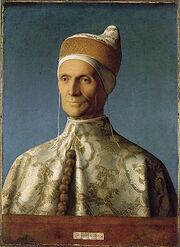
Count Leonardo Loredan, Viceroy of Veneto
In 1521 C.N., over 1200 years of Hegemony rule had passed and done little to quiet the independent spirit and fierce loyalty of the Venetian people. It had long been hoped in Venezia and, indeed, across Europe that one day their beloved monarch, Lee Allen II, would be restored to the Venetian throne. For over a thousand years, the Venetian people dogged their conquerors with an unrelenting guerrilla war that resulted in countless casualties on both sides over many generations. Anti-Hegomony sentiment was near fever pitch when Count Leonardo Loredan, the leader of the Venetian Independence Force (at the time, the most powerful guerrilla militia in the Veneto) issued a general decree of independence to the Hegomony, in doing so calling every remaining militia into action. Simultaneously, a dispatch was sent to His Imperial Grace in Blickling by Loredan calling for aid and promising his full restoration. His Grace acted quickly. On March 2, 1521 C.N., the combined forces of Count Loredan and His Grace began the siege of Venice. For six days and nights the Hegomony garrisons were blasted and reduced to rubble. Inside the city walls, fueled by over a millenia of Hegomony tyranny, many heroic Venetians braved fire and hails of bullets to take their oppressors from behind. When the last shot rang through the mist at daybreak on the 8th of March, not a single Hegomony soldier was left standing in the city. Lord Lee Allen was welcomed into the city as a conquering hero. On March 9, he was (re)corinated Il Doge Segundo di Venezia. As his first act as Doge, His Imperial Grace named Count Loredan as Viceroy of the newly reinstated Duchy of Veneto. In the ten years that followed, like his father before him, His Grace meticulously restored the city of Venice to her former glory.

Lady Abriana, Grand Duchess of Thornbury
It was during this time that the Grand Duke met Count Loredan's daughter, Abriana of Castello. In 1531, on May 12, the Grand Duke married her, (by proxy in Venice on May 2, subsequently at the Universalist Temple in Blickling). On May 29, she was crowned Duchess Consort, and in the four years that followed, Lady Abriana became a staunch advocate for the poor and homeless. She spearheaded thirteen initiatives that sought to educate underprivileged children, founded six schools, two hospitals, and three charities all for the benefit of the impoverished and unemployed. Her charity was not limited to Thornbury; she made continual efforts in the war-torn regions of Africa and the Middle East to protect and educate thousands of orphans. She, in every conceivable way, embodied the ideals of a Humanitarian Queen, and her people loved her dearly for it. In 1535, a day of national celebration was declared when she and the Grand Duke announced the impending birth of their first child. On January the 23rd, 1536, the couple's only son, HRH Prince Lee Allen III, was born at Norfolk Palace in Blickling. Eleven months later on November 30, their first daughter, HRH Princess Sylvia, was born, followed on December 11, 1537 by HRH Princess Eleanor. Tragedy soon followed these myriad jubilations; on December 12, Lady Abriana died of labor complications. Before the autopsy, however, a midwife was accused of malpractice in the national newspapers. She was eventually exonerated, but a rift was quickly forming between the Aristocratic class and the people. After Lady Abriana's death, the Grand Duke became increasingly more reclusive. Public relations worsened when in 1541, one of the late Grand Duchess's charities providing clean water in Sudan nearly went bankrupt; the Grand Duke was vilified in the newspapers and tabloids for having "... abandoned the passions and memory of our beloved Lady." In the Margrave of Saxony, republican ideals began to boil to the surface. The Aristocracy was on the decline.
The Dissolution Act of 1560[]

Red Sunday in Blickling
By 1554, republican sentiment that had first begun in the Margrave of Saxony, had already swept across Burgund, Aquitaine, and Thornbury. Much of the population had grown tired of the aristocratic Councilors' out-dated social policies and idle snobbery. When it was discovered in March of 1560 that the Rt Hon. Spencer T. Osbourne (Minister of Trade) had forced his personal servants, who numbered over two hundred, to live in squalid conditions with little food, it was the death-knell of the aristocracy. When the story hit the news papers on the 28th of March, violent riots broke out in Blickling, Plantier, and Pt. Nordby. 127 souls perished in what came to be called "Red Sunday." Most notable amongst the dead were Minister Osbourne and his ten year old son. In a public address given by His Grace from the Doge's Palace in Venice, he expressed his extreme sorrow over the state of the Grand Duchy:
| “ | ...I cannot fully express my shock and deep sense of grief over recent events in Blickling, Plantier, and Pt. Nordby. While I do not condone the human rights violations of the late Minister of Trade, the cold-blooded murder of the Minister and his young son is unforgivable, and those responsible will be brought to justice. With that said, it is obvious to me that the current government no longer fully meets the needs of the people. I am convening a national summit in Venice to directly address this situation. My intention is to dissolve the Monarchical and Representative branches of the government, and instate in their place, a republican legislative body. Also, as part of this plan and due to the vast cultural diversity across Thornbury, I intend to offer independence to each état... | ” |
On March 29, the Venetian Council convened at the Doge's Palace in Venice. Out of the three hundred delegates, less than ten were serving Councilors. The delegation immediately broke into two factions: one siding with the de Medici banking clan in favor of the preservation of the aristocracy, and the other led by popular philosopher Brian Swimme who urged the importance of an egalitarian governmental system. On April 2 the pro-egalitarians won out, and the terms of the Venetian Accord were published.

The Doge's Palace, Venice
| “ | ...This Day the Venetian Council has passed the most important Resolution, that ever was taken in Thornbury. We the free peoples of the Grand Duchy of Thornbury hold these truths to be self-evident, that all men are created equal, that they are endowed by their Creator with certain unalienable Rights...When in the Course of human events, it becomes necessary for one people to dissolve the political bands which have connected them with another, and to assume among the powers of the earth, the separate and equal station to which the Laws of Nature and of Nature's God entitle them, a decent respect to the opinions of mankind requires that they should declare the causes which impel them to the separation...Therefore, this day, the états of Thornbury, Aquitaine, Burgund, Veneto, and Saxony declare unchallenged and unmitigated independence... | ” |
As laid down by the Venetian Accord each état was granted independence and was given the ground work to establish republican governments therein. As part of the Accord, it was stipulated that the former Grand Duke would retain life rights to the title of "Grand Duke" and would be made a Venetian Conte (Count) in the new mixed republic of the Veneto (which was renamed Venezia).
However, the Grand Duke had little time to enjoy the success of his humanitarian endeavors. On Sunday, April 4, the Grand Duke fell ill with pneumonia. After a brief struggle, he died two days later on Tuesday, April 6, 1560 at the Doge's Palace. Candlelight vigils were held across the former grand duchy in remembrance of the man who brought them to global prominence and independence. After lying in state for three days at St Mark's Basilica, he was entombed on April 10 on the Isola di San Michele in his native Venice. He was survived by his three children: HRH Prince Lee Allen du Sensibaugh III, HRH Princess Sylvia Jennifre, and HRH Princess Eleanor Eugenia. The title of "Conte" passed to his only son, the Prince, who would later become Doge Leo III of Venezia.
Government[]
Though founded on the principals of strict, conservative monarchy, after a brief political "coup," incited by the Grand Duke in the late 1390s, The Grand Duchy of Thornbury is, today, a Parliamentary Monarchy. The grand duchy is split into five États: the Duchy of Thornbury, the Duchy of Aquitaine, the Duchy of Burgund, the Duchy of Veneto, and the Margrave of Saxony. The Governmental body of the grand duchy is split into three parts: Monarchical, Representative, & Judicial. The following is a brief overview of the current Thornburian politics.
Monarchical Branch[]
The Monarchical Branch of the Thornburian government is currently headed by His Most Imperial Grace, Lord Lee Allen du Sensibaugh II, 1st Grand Duke of Thornbury. The executive powers maintained by this branch of the government include the appointment of Ministers, appointment of High Court Justices, and setting the cap on annual taxation. Many other responsibilities have traditionally been tied to the office of the Grand Duke, such as management of public parks, land, and structures, the purchase of infrastructure, and appointment of ambassadors. In the event of corrupt or unpopular law, it is the right of His Grace, the Grand Duke to sue the High Council in the High Court for revision or dissolution of said law.
Out of the elected body of the High Council, the monarch must appoint a Privy Council of Ministers. Ministerial positions are held for life except in cases of dismissal, abdication, or impeachment (which requires a majority vote in both the High and Low Councils). The positions and their current holders are listed below:
- Prime Minister: The Rt. Hon. Lynwood D. Mason III (Note: this is the only position in the Privy Council of Ministers that is elected by the High Council.)
- Minister of the Treasury: The Hon. James Burgwyn
- Minister of Labor: The Hon. Ambrose Lacey
- Minister of Trade: The Rt Hon. Spencer T. Osbourne
- Minister of State: Dame Melissa Rolls Link-Wise
- Minister of Technology: Sir Hugh Lawrence Mining, Ph.D.
- Minister of Justice: Sir M. F. Link, Esq.
- Minister of Defense: Lord Admiral Rawdon Pitt-Crawley
- Minister of Agriculture: The Hon. Cassandra M. C. Walsh
- Minister of Health: Dr. Garland C. Shull, M.D.
- Minister of Scholastics: The Rt. Hon. Eglantine J. Peirce
- Minister of Transport: Lady Breanna Bonham Castle
The monarch must not only oversee the the appointment of Viceroys to Aquitaine, Burgund, and Veneto, but also the nomination of no fewer than three candidates for the office of Governor of Saxony (as circumstances dictate). Viceregal and Governorial positions are held for life except in cases of dismissal, abdication, or impeachment (which requires an 80% majority vote in the High Council). The positions and their current holders are listed below:
- Viceroy to the Duchy of Aquitaine: Lorenzo XII de Medici
- Viceroy to the Duchy of Burgund: Jean-Louis du Valois
- Viceroy to the Duchy of Veneto: Count Leonardo Loredan
- Governor to the Margraviate of Saxony: Sir Garrick Q. Wright
Representative Branch[]
Known as the Council of Three Hundred, the High and Low Councils make up the main bodies of the Representative Branch. In bicameral fashion, the High Council is populated by 100 High Councilors, 20 from each état, while the Low Council is populated by 200 Low Councilors whose number of seats are dictated by percentage of the total population of the grand duchy in each état. All Councilors are elected by the people, High Councilors every five years, Low Councilors every two and a half years, on a rotating calendar. Though most governmental powers in the grand duchy, arguably, reside with the Monarchical Branch, the High and Low Councils do maintain some legal importance. The Councils maintain the power to declare war, regulate domestic taxes, write social law, and impeach persons in the Privy Council of Ministers and the High Court. It is the duty of the Prime Minister to set the agenda annually for the High Council, as the Minister of State does in the Low Council.
Judicial Branch[]
The Judicial Branch of the duchy is headed by the High Court, which is housed in the Link Building (aka the Ministry of Justice). Presiding over the High Court are thirteen Chief Justices, led by Sir M. F. Link, Esq. the current Minister of Justice, for whom the building is named. All Chief Judicial positions are appointed for life by His Grace, the Grand Duke. Responsibilities of the High Court include interpreting High Council Law, presiding over international legal proceedings, and final rulings on appellate trials and disputes.
Political Parties[]
The politics of the Grand Duchy of Thornbury are run on a multiple party system. Founders agreed that this would allow for every voice to have its chance to be heard. Parties can be, and historically have, ranged from as little as one person to thousands. Listed below are just a few of the larger active parties in the duchy, their position, percentage of the voting population registered as such, and number of seats held in the High Council:
- Tory: Conservative/Pro-Monarchy, 45%, 45 Seats
- Whig: Liberal/Pro-Republic, 41%, 41 Seats
- Respect Coalition: Far Left/anti-war/Pro-Socialism, 12.5%, 13 Seats
- Thornbury Independance Party: Far Right/Eurosceptic, 1.5%, 1 Seat
Blickling, the Marble City[]

Life in Blickling
On May 17, 1218, during his tour of the duchy, His Grace, Lee Allen II met with Daniel Burnham and Frederick Law Olmsted to begin planning the new capitol city. The original village of Blickling was largely built to maintain Blickling Hall. With a native population of 136, the sleepy shire township would not sustain the new government and rapidly growing population of Thornbury.
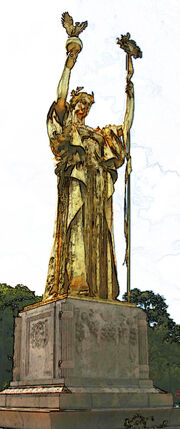
Artist's Rendering of the Statue of Lee Allen II
Together, His Grace, Burnham, and Olmsted undertook the arduous task of designing a governmental seat where before only pastures and marshland had resided. They decided to place the new capitol on the eastern shore of Lake Blickling and design it to the standards of the City Beautiful Movement. The lake was multiplied in size more than ten times and a canal connecting it to the North Sea was built, as well. What resulted is a symphony of civil architecture. The new city of Blickling is lined with lush gardens, wide canals, and monumental buildings which house the government of the grand duchy.
Construction of the city was completed and inaugurated on the 12th of June, 1219. Blickling boasts an entirely green power grid, completely generated from Wind and Solar energy, state-of-the-art waste treatment and recycling plants, free public transport, over 700 restaurants, and 23,000 private businesses, not to mention housing, ranging from posh townhouses to suburban dream homes, to accommodate the city's ever growing population. Part of the city, Lakebridge, in the Civil District, was actually reclaimed from Lake Blickling in order to properly align the new city's streets with pre-existing motorways and create proper protection for the man-made canals that intersect the streets and give definition to the different sectors of town.
On the Southeastern corner of Lake Blicking is the Civil District where the ministries of the government are seated. The Civil District is broken into five distinct sectors: Temple Square, the Venetian Harbor, Lakebridge, Hundley Park, and Council Hill.
The northern part of the Civil District, known as Temple Square, contains the Ministry of the Treasury, the Ministry of Defense, the Ministry of Technology, the Academy of the Fine Arts, and seated dramatically in the center of the square, the Universalist Temple, for which the square is named.
The northwestern part of the Civil District, called the "Venetian Harbor" for its grand Venetian Memorial running through its center, also contains the Grand Arena, the Ministry of Trade, an expansive harbor directly abuttressing the Venetian Memorial Sea Gate, a Customs House, and numerous warehouses for storing tradeable goods.
The western side of the Civil District, Lakebridge, runs from the Ministry of Transport to Stout Street on the south side of the Ministry of Labor. It also contains St. Freya's Market, which is overwhelming in its grandeur and scale, the Ministry of Justice, and extensive Italianate gardens.

Artist's Rendering of Council St.
The center of the Civil District is defined by a lush natural lagoon, in the center of which sits the Avalonian inspired, verdant isle of Hundley Park. The park-island is host to a myriad variety of flora and fauna along with a half dozen Japanese style pavilions ranging in purpose from park stage to wildlife exhibits.
In the south-central part of the Civil District stands the Hall of the High Council, which marks the elegant Council Hill district surrounding the the Hall on its east, south, and west sides. The Council Hill district is home to the Lord Mayor of Blickling, the Minister of Finance, and numerous other persons of power and affluence in the grand duchy.

Monument Park in the Bishoprook
Dominating the northern and eastern sides of the Civil District is the second largest sector and suburban dream neighborhood, the East Village. It not only contains over 4,500 hectares of planned suburban estates on quiet chestnut tree lined streets, but it is also home to the Ministry of Agriculture, the Hall of Records, the Ministry of State, the Ministry of Scholastics, the Ministry of Health, and the Cauthorne Museum of Natural History. In the center of the East Village is a year-round fun fair, perfect for family outings.
Directly North of the Civil District, on the shores of Lake Blicking is the fashionable suburb of Shoreline, a charming neighborhood filled with gated estates lining sandy beaches. It has been nick-named the "Beverly Hills of Blickling."
To the West of Council Hill, sitting in Lake Blickling, is the small, lush Isle of Osbourne, home to the Osbourne Academy and Osbourne Hall (ancestral home of the Earls of Cambridge).
On the South side of Council Hill and wrapping around Blickling Hall and the South end of Lake Blickling is the largest sector of town, the Bishoprook, named for Bishoprook Hill, an immense and elegant park crowned by the dramatic Bishoprook Folly, at its center. The Bishoprook is home to Blickling's financial district, which is reflected in its impressive modern skyline, as well as a thriving bohemian art scene and over one hundred night clubs and dance halls.
Map of the Civil District[]

Map of the Civil District at Blickling
KEY:
A) Fair Grounds, B) East Village, C) Ministry of Agriculture, D) Hall of Records, E) Ministry of State, F) Cauthorne Museum of Natural History, G) Ministry of Health, H) Ministry of Scholastics, I) The Hall of the High Council, J) Ministry of the Treasury, K) Ministry of Defense, L) Universalist Temple, M) Ministry of Technology, N) Academy of the Fine Arts, O) Hundley Park, P) Ministry of Labor, Q) Grand Arena, R) Ministry of Trade, S) St. Freya's Market, T) Ministry of Justice, U) Venetian Memorial Sea Gate, V) Abbey of Our Lady Freya, W) Venetian Memorial Lagoon & Statue of Lee Allen II, X) Customs House, Y) Ministry of Transport
Other Major Cities[]

The Grand Duchy of Thornbury
Venice, Veneto[]
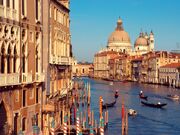
Grand Canal, Venice
Founded in 421 C.E., Venice is the glittering financial and fashion capital of the grand duchy and is the birthplace of His Imperial Grace. Capital of the Duchy of Veneto and containing 27% of the nation's total population, it is the second largest city in the country. Governed by Viceroy Count Leonardo Loredan, the city and its surrounding lands were reconquered by His Grace in 1521 C.N. Venice is world renowned for its production of fine jewelry and furs. Known as the "Queen of the Adriatic," Venice is a symphony of grand and rare architectural gems including the Fenice Opera House, the Doge's Palace, and literally thousands of regal palazzos. Comprised of 117 islands encompassing 150 canals and over 400 bridges, Venice has a land mass of less than twice that of NYC's Central Park.
Plantier, Aquitaine[]

Plantier
Erected on the former site of Noirmoutier-en-l'Île in 1384 C.N., Plantier serves, chiefly, as port town to the vast private plantation of His Grace. It is the capital city of the Duchy of Aquitaine, and seat of His Grace's government therein, which is headed by Viceroy Lorenzo XII de Medici. A bustling harbor town, Plantier is home to roughly 22% of the total population of the country, making it the third largest city in the grand duchy.
Port Nordby, Saxony[]

Port Nordby - Wunderplatz
Known as the "Gateway to the North," Port Nordby was erected near the former site of Skagen. Capital of the Margraviate of Saxony, the état's governance is overseen by former Minister of Defense, Governor Garrick Q. Wright, Second Baronet Tarkwyn. Home to roughly 20% of the grand duchy's total population, Port Nordby is a model of green urban living. The city proudly boasts an entirely green power grid, the second largest in the grand duchy, and is home to GreenCorp, the largest alternative energy firm in Western Europe.
Colmar, Burgund[]

Colmar - Place Royale
Situated on the Alsatian Wine Route in the heart of the Hautes Vosges Mountains, Colmar is considered to be the "Capital of Alsatian Wine." It is the capital of the Duchy of Burgund where the governance of the duchy is administered by Viceroy Jean-Louis du Valois. A major over-land trade center, it is home to roughly 13% of the grand duchy's total population. Traditionally a familial holding of the Sensibaugh Dynasty, it was returned to His Grace's holding in 1395 C.N. Since then, it has been lovingly and painstakingly restored to its original medieval charm. The city is renowned for its well preserved old town and its numerous architectural landmarks and museums. It is connected to the English Channel, via canal, by the Rhine River.
Culture[]
Thornburian culture is one of mixed extremes; it is, at one time, both conservative and artistic, traditional and still yet, progressive. "Ways of Old" are prized equally beside new ways of thinking. Thornburian subjects are renowned for their industriousness, strong sense of tradition, and their love of learning.
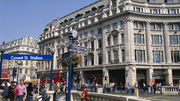
Fashionable shops on Covent St.
Their fine education system is the envy of all Anglia and is in-session year-round. Founded on the principals and teachings of the great Lucy Cavendish, enrollment is open and free of charge to all Thornburian subjects from primary school all the way through undergraduate studies. Likewise, the National Health Innitiative (headed by the Ministry of Health) ensures that every Thornburian has the right and the means to obtain proper medical care. Despite the seven day work week and six day school week, generous holiday packages are offered by the state and most private employers.
Thornburians enjoy an extremely high quality of life due, in no small part, to their entirely green power grid. Blickling has one of the lowest pollution rates in Europe thanks to its first-class recycling and waste management system. The streets are lined with Chestnut Trees and the city is littered with over forty public parks. Public transport serves the city and its surrounding areas at no charge. At this time there is no calculable crime rate.
The arts are among the most highly prized of virtues in the duchy, all of which are over-seen and supported by the Academy of the Fine Arts. Naturally, therefor, the Duchy of Thornbury is an ideal destination for artists and art lovers alike. The Academy supports numerous gallery openings, museum exhibitions, and theatrical productions throughout the year. The East Village Players are currently teaming up with the Academy to build a monumental new playhouse on Cauthorne St., which will contain seating for up to 12,000 patrons.
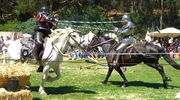
Jousting Knights at Blickling's Annual Medieval Fair
City life in Blickling is a merging of quiet neighborhoods and busy urban thoroughfares. The common mindset there is one of openness, embracing all races, religions, and identities. Whether one desires a fun night on the town with friends or a relaxing day in the park, drinking and dancing until dawn or pensive afternoons at the Cauthorne Museum, Blickling offers a veritable buffet to suit any interests. There is always something happening in Blickling; there are annual medieval jousting tournaments at Northampton Park and a PRIDE Parade is in the works for Summer '09. Fashionable boutiques, exquisite restaurants, and trendy night spots line the streets of Council Hill. The outlying regions of the duchy are dotted with verdant hills, sweeping seascapes, and quaint pastoral farms. The Aylsham suburbs to the east of Blickling, are a beautiful place to soak up the indigenous history of the area. The City of Norwich and the East-Anglian coast are less than an hour's drive, and both make for a popular day trip or a holiday destination.
Relocating to Thornbury[]
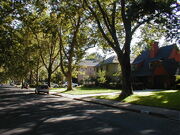
Blickling's Chestnut lined neighborhoods are an ideal family paradise.
- See also: Blickling Metropolitan Realty
There are numerous opportunities for those wishing to immigrate to the Duchy of Thornbury. In addition to safe neighborhoods, beautiful parks, and a high standard of living, the government of the Thornbury will also subsidize real purchases in the city of Blickling, up to 40% for those wishing to help the young city grow. If you are interested in relocating to Blickling, please, contact the Office of His Grace, the Grand Duke of Thornbury, directly.
At this link you will find just a few of the many opportunities for home-ownership in the fast-growing city of Blickling. Prices have not been pro-rated to reflect potential government subsidies.
Landmarks[]
Ministries[]
- Ministry of Justice: The Link Building, named for Michael F. Link, not only houses the highest courts in the land; it also contains the poll of the electorate and the Bar Association. The Link Building is also home to the famous Pig's Head Pub, the symbol of which is a police officer's head on a plaque, a popular place for barristers and judges to have a "pint."
- Ministry of Technology: The Mining Building, named for and headed by Sir Hugh Lawrence Mining, Ph. D. of Nanotechnology, is the center of technological production in the grand duchy.
- Ministry of Agriculture: The red brick structure has a monumental golden entry fashioned in the Moorish style.
- Ministry of State: The Link-Wise Building, which houses the Ministry of State, is a revolutionary design incorporating both Earth-friendly yurt and monumental Neoclassical architecture.
- Ministry of Scholastics: The Cavendish Building, named for Lucy Cavendish, features one of two monumental gold domes in Blickling.
- Ministry of the Treasury: One of the largest civil buildings in the grand duchy, the Burgwyn Building also houses the ducal mint.
- Ministry of Defense: Military Headquarters
- Ministry of Labor: Administrative headquarters for the the laboring forces of the grand duchy.
- Ministry of Trade: Seat of the Uniform Trade Board
- Ministry of Health: Headquarters for the nation's, state-regulated, socialized health care system.
Ducal Endowments[]
- The Medici Bank of Blickling (Banque du Medici, Banco de Medici): The imposing Blickling branch of the Medici Bank is a powerful testament to the economic might of the grand duchy. It is headed by Conte Giulio IX de Medici, younger brother of the current Viceroy of Aquitaine. The building stands in Privy Garden Blvd in Council Hill.
- The Medici Bank of Venice: Built in 1260, the Medici Bank of Venice occupies the former Scuola Grande di San Marco.
- The Medici Bank of Plantier: The breath-taking Plantier branch of the Medici Bank is built in the French Renaissance style. It stands on the Place du Carnavalet.
- The Valois Bank of Pt. Nordby: The Port Nordby branch of the Valois Bank is an architectural gem built in the Neoclassical style. The main offices are located at #1 Academy Row, le Place du Valois.
- The Valois Bank of Colmar (Banque du Valois, Banco de Valois): Capitol seat of the Valois banking dynasty, the impressive Colmar branch of the Valois Bank is presided over by Chevalier Charles du Valois.
- The Royal Foreign Ministry: The Royal Foreign Ministry is housed in the former palace of the Earl's of Sussex. It stands in Endlsleigh Close in the Council Hill District.
- The Osbourne Academy: First of the schools built by His Grace the Osbourne Academy was modeled after Tryon Palace, and is an all boys school. It stands on the Isle of Osbourne, in Blickling, from whence it gets its name.
- The Cavendish School for Girls: The third school endowed by His Grace is founded on the teachings of Lucy Cavendish. The building itself was inspired by the main building of the Fordson School in United States. The Cavendish School stands at the intersection of Devonshire Ave. and Garden St. in the Garden District of the East Village.
- L'Ecole d'Aquitaine: Located in the heart of Plantier, l'Ecole d'Aquitaine is renowned for its advanced studies in the arts and linguistics. The building itself sprawls over four city blocks encompassing an enormous quadrangle. L'Ecole d'Aquitaine is a coeducational school.
- L'Ecole du Cleves: Standing on the Champs de Mars in Colmar, l'Ecole du Cleves is designed in the Louis XIII style. L'Ecole has won numerous awards for its superior science and mathematics departments. L'Ecole du Cleves is a coeducational school.
- The Ducal Academy of Arts & Sciences: The regal edifice of the Ducal Academy of Arts & Sciences dominates the Ducal Square in Port Nordby.
- Blickling University: The oldest university in the grand duchy, Blickling University offers a wide array of study for degrees on the Bachelor, Masters, and Doctoral levels. It is located on the northeastern edge of the East Village; it's main offices are in Sea Gate Blvd.
- L'università Ducale: Built in 1560 and attributed to Giangiacomo de' Grigi, the Ducal University is housed in the former Scuola Grande di San Rocco.
- Grand Arena: First Ducal Endowment errected in the Duchy, the Grand Arena is home of the Thornbury Thestrals, Thornbury's national soccer team, and stands at the North end of the Civil District.
- East Gate Gardens Sports Complex: East Gate Gardens, a revolutionary new kind of sports facility, stands on East Gate Blvd. in the East Village.
- Colmar Stadium: This monumental sports center is a symphony of glass and steel. It stands at the corner of Holkham Terrace E. and Charlotte St. in the East Village.
- Thurston Statdium: Named for it's architect, the Thurston Stadium stands on the corner of Boleyn Crescent W. and Monument Ave. S. in Bishoprook.
- Dunrobin Stadium: Modeled after the Cowyboys Stadium in the United States, this impressive structure stands on Peninsula Blvd. S. in Bishoprook.
Other Landmarks[]
- Academy of the Fine Arts: Center for the Royal Society of the Academy of Fine Arts. The Academy is entrusted with management and dispersal of annual endowments and grants to the native artistic community of Thornbury.
- Cauthorne Museum of Natural History: Built in honor of Lord Henry, 6th Earl of Cauthorne, whose generous endowment made its existence possible.
- The Hall of the High Council: This imposing example of Neoclassical architecture dominates the south-central district of town.
- Universalist Temple: A gold-domed Unitarian Universalist Temple will occupy the center of the Temple Square.
- Hundley Park: Named for Sir Franklin Young Hundley, 4th Marquess of Essex, and chief benefactor of Thornbury.
- St. Freya's Market: The largest, and perhaps, most imposing building in the capitol. The market, seen here with Hundley Park in the foreground, is home to the trading floor where the duchy's rubber and silver industries meet.
- Customs House: Extension of the Ministry of Trade. All incoming foreign goods must come through this checkpoint before entering the duchy.
- Home to the Lord Mayor: Number 1 Council Street is the home to the Lord Mayor of Blickling. This grand Italianate Maison du Ville features an indoor pool, over half a dozen state-rooms, and numerous elegant spaces for entertaining. Number 1 Council Street also houses the Offices of the Lord Mayor.
- Home of the Minister of the Treasury: This stunning chateau on Stout Street, in Council Hill, is the private home of Thornbury's Minister of Finance and is immediately adjacent to the Blickling Yacht Club. The picture shown here was taken during the Minister's inaugural "House Warming Ball."
- Blickling Hall: The Private Noble Residence. The Ducal Palace was built during the reign of James I in 1616 by Robert Lyminge for Sir Henry Hobart, 1st Baronet of Intwood]. It is the familial holding of Lord Lee Allen II, 1st Duke of Thornbury, 5th Marquess of Essex.
- Norfolk Palace: Official State Residence of the Dukes of Thornbury. A later addition to the Council Hill District, the original structure was purchased from the Earl of Norfolk. After considerable remodeling, Norfolk Palace was styled after Somerset House in London and sits on Privy Garden Blvd.
- Osbourne Hall: This intimidating structure, modeled after Hagley Hall in Worcestershire, is the ancestral home of the Earls of Cambridge, and sits on the Isle of Osbourne, from which it takes its name. It is, at present, home to the current Minister of Trade, The Rt Hon. Spencer T. Osbourne, Fourth Earl of Cambridge.
- Bishoprook Folly: Originally built as a defense tower at the southern extreme of the city walls, Bishoprook Tower now stands at the center of Blickling's sprawling financial district. Originally modeled after Paxton's Tower and surrounded by a verdant park, the Bishoprook Tower now houses the Crown Jewels of State.
- Abbey of Our Lady Freya: Dedicated to the Norse goddess Freya, the Abbey is home to over 120 devotees of the order. Note: Freya is considered by Thornburians to be the personification of the Duchy of Thornbury.
- Chateau du Sens: This exquisite chateau is the seat of His Grace's personal rubber plantation and vinyard. The estate itself sprawls over 7,500 sq. miles made up of the former county of Poitou and is completely self-sufficient. The stunning chateau was fashioned after Chateau Hautefort in the Périgord region. Though its regal Main Gate is located in Plantier, proper, the chateau actually stands nearly twenty miles from town.
- Palazzo Ducale di Venezia: Constructed between 1309 and 1324, the Ducal Palace is by far, the grandest residence in all Veneto. It is in the late Venetian Gothic style and stands in Piazza San Marco. An official residence of state to the Grand Duke's of Thornbury, it is traditionally home to the Viceroys of Veneto.
- Palais d'Aquitaine: Official state residence of the Viceroys of Aquitaine, the Palais d'Aquitaine is an exact replica of the Palais du Luxembourg.
- Governor's Palace: Not only does this imposing palace act as the official state residence to the Governors of Saxony, but it also houses the Althïng, the highest court in the Margravate.
- Chateau Burgund: Built in 1390 C.N., this imposing chateau is the official state residence of the Viceroys of Burgund. It was heavily modeled after Chateau Langeais.
References[]
- ↑ John Barwell, n.d. "A History of Norfolk."
- ↑ Anon, 2002. Norfolk History.





